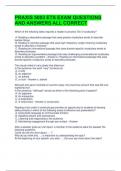Exam (elaborations)
PRAXIS 5003 ETS EXAM QUESTIONS AND ANSWERS ALL CORRECT
- Course
- Institution
PRAXIS 5003 ETS EXAM QUESTIONS AND ANSWERS ALL CORRECT Which of the following tasks requires a reader to process Tier 3 vocabulary? A. Reading a descriptive passage that uses precise vocabulary words to describe familiar things B. Reading a narrative passage that uses high-frequency, sing...
[Show more]



